SCIENCE REPORTER SUMMARY: FEBRUARY 2025
ARTICLE 1
Human Metapneumovirus (HMPV):
- Human Metapneumovirus (HMPV), though identified in 2001, is now receiving attention due to a rising number of detected cases globally.
- Initially overshadowed by more prominent respiratory infections like influenza and RSV, the recent increase in HMPV cases, especially in high-density countries like India, has raised public health concerns.
What is HMPV?
- HMPV belongs to the Pneumoviridae family, which includes Respiratory Syncytial Virus (RSV).
- It can infect individuals of all age groups, including infants, young children, the elderly, and those with compromised immunity or underlying health conditions such as asthma and Chronic Obstructive Pulmonary Disease (COPD).
Symptoms and Transmission
- Common Symptoms: Fever, cough, nasal congestion, and shortness of breath. Severe cases can lead to bronchitis or pneumonia.
- Transmission: Spreads through secretions from sneezing, coughing, close physical contact, and touching contaminated surfaces before touching the face.
Expert Insights
- Experts from Vaccine Immunology at Imperial College London, stated that HMPV presents similar symptoms to RSV and has likely been circulating for much longer than its discovery in 2001.
- The World Health Organization (WHO) recently highlighted increased cases of acute respiratory infections, including HMPV, contributing to the healthcare burden during the winter season.
Preventive Measures
- Maintain good hygiene (frequent handwashing).
- Avoid close contact with infected individuals.
- Wear masks in crowded or poorly ventilated areas.
- Clean and disinfect surfaces regularly.
- Improve ventilation in living spaces.
- Strengthen immunity through a balanced diet and a healthy lifestyle.
ARTICLE 2
Altermagnetism: A New Class of Magnetism
- Magnetism, a key field in condensed matter physics, has traditionally been classified into two types — ferromagnetism and antiferromagnetism.
- A new form of magnetism called Altermagnetism has emerged, combining features of both and opening new avenues in physics, chemistry, and material science.
- This discovery was recently reported by Peter Wadley and his team in Nature.
What is Altermagnetism?
Altermagnetism is a collinear magnetic phase with a compensated magnetic order where opposite-spin sublattices are related by crystal-rotation symmetries. Unlike traditional ferromagnets and antiferromagnets, altermagnets exhibit:
- Vanishing net magnetisation despite spin splitting.
- Time-reversal symmetry breaking similar to antiferromagnets.
- Alternating momentum-dependent signs of spin splitting in electronic band structures.
Unique Properties
Altermagnets possess an unusual combination of ferromagnetic and antiferromagnetic traits:
- Anomalous spin currents and Hall effects.
- Electronic behaviours like spin-split bands despite net-zero magnetisation.
- Spin-polarisation order linked to crystal symmetry.
These properties enable phenomena previously considered impossible in conventional magnets.
Potential Applications
Altermagnetism could have far-reaching applications in:
- Spintronics – Enhancing data storage and processing.
- Nanotechnology – Developing high-efficiency magnetic devices.
- Superconductors and quantum computing – Improving data accessibility and device efficiency. Precise control over altermagnetic states could lead to more efficient electronic devices, including hard drives and mobile chips.
ARTICLE 3
Conservation of Himalayan herbs: manoeuvring plant tissue culture for this purpose
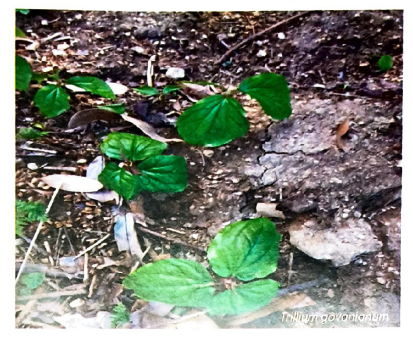
- High-altitude Himalayan herbs, known for their medicinal properties, have long been valued in traditional remedies.
- The growing market demand for these herbs has highlighted their medical potential, but it has also led to overharvesting, threatening their natural regeneration.
- Sustainable conservation strategies are now essential to protect these valuable plant species.
Threat from Overharvesting
- During a trek to Kamrunag Lake, signs of soil digging indicated unchecked harvesting of medicinal herbs.
- Local villagers confirmed that this was to collect high-value herbs.
- Excessive and unsustainable harvesting has pushed many species into the IUCN threat categories, raising concerns over their survival.
Role of Plant Tissue Culture
- Tissue culture offers a promising solution for conserving endangered Himalayan herbs.
- Plant cells have the ability of totipotency — the potential to regenerate into a whole plant.
- Through tissue culture, excised plant parts are grown under controlled conditions with tailored nutrients and hormones, enabling rapid multiplication of rare species.
Advantages of Tissue Culture
- Year-round production – Overcomes seasonal and geographical limitations.
- Controlled biosynthesis – Ensures steady accumulation of medicinal compounds.
- Preservation of genetic diversity – Helps conserve plant species without disturbing natural habitats.
ARTICLE 4
IIT Madras Releases the most detailed 3D High-Resolution images of the Human Fetal Brain
- IIT Madras has become the first research institution globally to release high-resolution 3D images of the fetal brain.
- This pioneering achievement by the Sudha Gopalakrishnan Brain Centre places India at the forefront of brain mapping science, creating a valuable global resource for neuroscience research.
Development of DHARANI Dataset
- The dataset, named ‘DHARANI’, comprises 5,132 brain sections captured using advanced brain mapping technology.
- It is an open-source dataset, making it accessible to researchers worldwide.
- This project was completed at less than 1/10th of the cost compared to similar Western projects, showcasing India’s efficiency in scientific research.
Multidisciplinary and Global Collaboration
- The research involved experts from India, Australia, the US, Romania, and South Africa and was supported by Chennai-based Mediscan Systems and Saveetha Medical Hospital.
- The project reflects a successful Public-Private-Philanthropy Partnership (PPPP), with support from the Government of India, Infosys, Fortis Healthcare, and NVIDIA (for processing large data volumes).
Scientific and Medical Impact
The detailed fetal brain atlas includes over 500 brain regions mapped at cellular resolution. It is expected to advance:
- Early diagnosis and treatment of developmental disorders (e.g., autism, learning disabilities).
- Improved understanding of brain development from fetal stages to adulthood.
- Enhanced fetal imaging technologies and neurodevelopmental disorder research.
Global Recognition and Future Potential
- The research has been published in the Journal of Comparative Neurology and positions India alongside global leaders like the Allen Brain Institute.
- The DHARANI dataset, advancing brain mapping by 20X, is anticipated to drive new discoveries and breakthroughs in neuroscience, reinforcing India’s status in global brain research.
ARTICLE 5
Fine particulate air pollution may play a role in adverse birth outcomes
- A study by the Harvard TH Chan School of Public Health has shown that exposure to fine particulate matter (5) during pregnancy can alter immune responses, potentially leading to adverse birth outcomes.
- This is the first study to analyze the relationship between PM2.5 and maternal-fetal health at a single-cell level, revealing significant health risks for pregnant women.
Biological Pathways and Immune Response
- Researchers calculated PM2.5 exposure using Environmental Protection Agency (EPA)
- They analyzed immune response changes in both non-pregnant and 20-week pregnant women at a cellular level.
- 5 exposure was found to modify histones (proteins that regulate gene activity), leading to abnormal cytokine release.
- This increases inflammation, which can negatively impact pregnancy outcomes.
Health Risks and Pregnancy Complications
PM2.5-induced inflammation in pregnant women was linked to increased risks of:
- Preeclampsia
- Low birth weight
- Developmental delays in early childhood
Policy and Clinical Recommendations
- Researchers emphasized the need for policy measures to improve air quality and clinical guidelines to reduce PM2.5 exposure during pregnancy.
- Minimizing pollution exposure could directly reduce pregnancy complications and improve maternal-fetal health outcomes.
Significance and Future Research
- The study’s innovative methodology provides deeper insight into how environmental factors affect pregnancy at a molecular level.
- Further research could lead to targeted interventions to protect maternal and fetal health from air pollution.
ARTICLE 6
WPS: A Hacker’s Gateway to Your Router
- Wi-Fi Protected Setup (WPS) was designed to simplify Wi-Fi configuration for home users by allowing quick connection to routers without a password.
- While it offers convenience, a major security flaw in the WPS PIN system has made it a target for hackers, compromising network security globally.
WPS Vulnerability and Brute-Forcing
- The WPS PIN is an 8-digit number split into two parts (4 digits each), validated separately.
- The total number of possible combinations reduces to 11,000 (10,000 for the first chunk and 1,000 for the second).
- Brute-forcing all combinations typically takes 4 to 8 hours.
Pixie Dust Attack
- The Pixie Dust Attack exploits flaws in the router’s “secret” generation process, reducing the cracking time to a few minutes or even seconds.
- This method works by analyzing data from the initial communication exchange, bypassing router security blocks after repeated failed attempts.
Ineffective Countermeasures
- Changing the router password or using Push Button Configuration (PBC) does not prevent Pixie Dust attacks since some routers have hard-coded PINs.
- Even disabling WPS on certain old routers may not work as the feature could still remain active.
- Vendor patches are not guaranteed to fix the issue.
Solutions and Best Practices
- Disable WPS in the router settings and confirm using a network scan.
- Replace outdated routers with newer, more secure models.
- Avoid using public Wi-Fi networks to reduce exposure to attacks.
- Educate users about WPS vulnerabilities and encourage safer network practices.
ARTICLE 7
VIRTUAL WATER
Rising Water Conflicts
- Between 1990 and 2023, over 1,473 water-related conflicts were reported worldwide, with two-thirds occurring in the last decade.
- Water conflicts can occur at both intrastate and interstate levels, especially between countries sharing transboundary water sources like rivers and groundwater.
- Freshwater scarcity impacts food security, economic stability, and living conditions, making water a potential trigger for future wars.
Hidden Water Consumption
- Beyond visible water usage for drinking, cooking, and washing, significant amounts of water are consumed indirectly through products and services.
- This “hidden water” is termed Virtual Water (VW), representing the water used throughout a product’s value chain.
Origin and Significance of Virtual Water
- The VW concept was introduced by British geographer Tony Allan in the early 1990s to address food security in water-deficient regions like the Middle East and North Africa.
- Allan proposed that water-scarce countries could import food and commodities containing VW, reducing direct water usage and conflict over natural resources.
- Allan was awarded the Stockholm Water Prize in 2008 for this groundbreaking idea.
Impact of Virtual Water Trade (VWT)
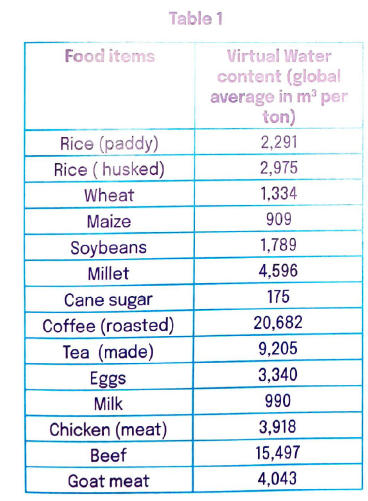
VW trade allows water-scarce nations to:
- Import high-water-consuming products (e.g., wheat) while exporting low-water-consuming products.
- Relieve domestic water stress by reallocating water for more productive uses.
- For instance, producing 1 ton of wheat requires 1,334 tons of water—importing wheat equals importing virtual water, conserving domestic resources.
Dietary Influence on Water Consumption
- A shift from a non-vegetarian to a vegetarian diet can save up to 8 cubic meters of water per person daily, highlighting the connection between diet and water availability.
Policy and Governance
Countries like Israel and Jordan have adapted their policies by reducing the export of water-intensive products to conserve resources. Policymakers can use VW analysis to:
- Encourage imports of high-VW products.
- Restrict exports of water-intensive goods.
- Manage water resources more effectively through strategic trade.
ARTICLE 8
White Hydrogen: The Ultimate Source of Clean Energy
- The Paris Climate Agreement (COP 21) of 2015 set a goal to limit global temperature rise to below 2°C and strive for 1.5°C compared to pre-industrial levels.
- It aimed to cut carbon dioxide emissions by 45% by 2030 and achieve net zero by 2050 (India targets 2070).
- This has driven a global shift from fossil fuels to renewable energy sources, with hydrogen emerging as a promising alternative.
- Currently, around 95 Mt of hydrogen is produced annually, with plans to increase it to 150 Mt by 2030, 216 Mt by 2035, and 430 Mt by 2050.
Types of Hydrogen
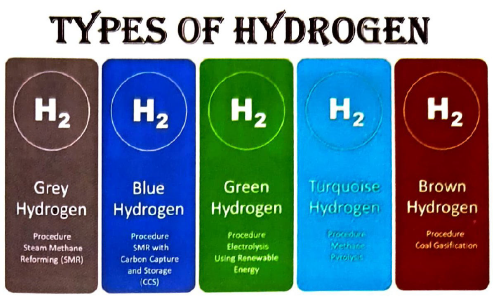
Brown and Black Hydrogen
- Brown hydrogen is produced from lignite (brown coal) and black hydrogen from hard coal through gasification.
- Both processes release high levels of carbon dioxide, making them environmentally damaging.
Grey and Blue Hydrogen
- Grey hydrogen is made from natural gas through steam methane reforming (SMR), producing significant carbon emissions.
- Blue hydrogen also uses SMR, but emissions are reduced via carbon capture and storage (CCS), cutting emissions roughly in half.
Pink and Turquoise Hydrogen
- Pink hydrogen is generated through electrolysis powered by nuclear energy, but it raises concerns about nuclear waste and costs.
- Turquoise hydrogen is produced by methane pyrolysis, generating solid carbon, but the technology is still in development.
Green Hydrogen
- Green hydrogen is produced via electrolysis using renewable energy like solar or hydro.
- While emission-free, its production costs ($3.80–$7.50/kg) remain higher than grey hydrogen ($0.90–$3.20/kg).
- Efficiency (60–80%) and high setup costs are challenges, but technological improvements are expected to increase efficiency fivefold by the decade’s end.
White Hydrogen – A New Opportunity
- White hydrogen, also called gold hydrogen, is naturally occurring and stored in the Earth’s crust.
- It was first discovered in 1987 in Mali, where a gas well fire led to the identification of 98% pure hydrogen.
- Subsequent discoveries in France and other countries have confirmed its presence at depths exceeding 1,000 meters.
- Its formation is believed to result from reactions between iron-rich minerals and subterranean water.
- Global reserves are estimated at 5.5 trillion tonnes, with even limited recovery capable of meeting annual global demand for hundreds of years.
Challenges and Potential of White Hydrogen
- White hydrogen is nearly emission-free but faces challenges in extraction, storage, and transport.
- Impurities like methane and water vapor need removal. Losses during storage (0.12–0.24% per day) and transport (13–15%) are significant.
- However, onsite generation at the source and advanced pressure vessels may reduce these issues.
- Its abundance and clean nature position white hydrogen as a key solution for future energy needs.
ARTICLE 9
Mission Mausam: India’s Leap towards Weather-Ready and Climate-Smart Future
Objective and Scope
- Mission Mausam, a ₹2,000 crore initiative approved by the Union Cabinet on September 11, 2024, aims to enhance India’s weather and climate forecasting capabilities by 2026.
- Spearheaded by the Ministry of Earth Sciences (MoES), the mission seeks to make India a “Weather-ready and Climate-smart” nation.
- It will deploy advanced technology and improve data collection, modeling, and dissemination systems to increase forecast accuracy by 10%.
Technological Upgrades and Forecasting Tools
- Advanced Weather Surveillance: The initiative will deploy:
- 50 Doppler Weather Radars (DWRs)
- 60 Radio Wind Stations
- 25 Wind Profilers
- 25 Radiometers
- 100 Disdrometers
- Enhanced Forecasting Models: AI and machine learning will be integrated with traditional weather models to improve predictions for monsoons, cyclones, and extreme weather events.
- Hyper-localized Forecasting: Global weather models will work at 5–12 km resolution, while regional models will operate at 1 km resolution, allowing more precise local forecasts.
Data Dissemination and Accessibility
- Mobile Platforms: Weather data will be accessible through apps like Mausam (general weather), Meghdoot (agriculture), and Damini (lightning).
- Last-Mile Connectivity: Forecasts will reach individual Panchayats and vulnerable communities through social and traditional media.
- Disaster Management: Improved early warning systems for floods and landslides will be integrated with the Geological Survey of India and the Central Water Commission.
Strategic and Global Collaboration
- Partnerships with national and international agencies (IMD, IITM, NCMRWF) will enhance research and technological advancements.
- Capacity building through education and research will improve local expertise in meteorological science.
Impact on Society and Economy
- Agriculture: Farmers will benefit from precise rainfall and temperature data, improving crop planning and reducing losses.
- Fishing and Aviation: Safer and more efficient operations due to improved weather predictions.
- Construction and Infrastructure: Better planning and reduced weather-related disruptions.
Vision for Climate Resilience
- Mission Mausam aims to make India a global leader in weather forecasting and climate resilience.
- By improving prediction accuracy and response systems, it will strengthen India’s preparedness for climate variability and extreme weather events, ensuring safety and economic stability.
ARTICLE 10
Submarine Groundwater Discharge: A Unique Phenomenon of Freshwater Springs in the Salty Coastal Seas
Freshwater in Coastal Seas
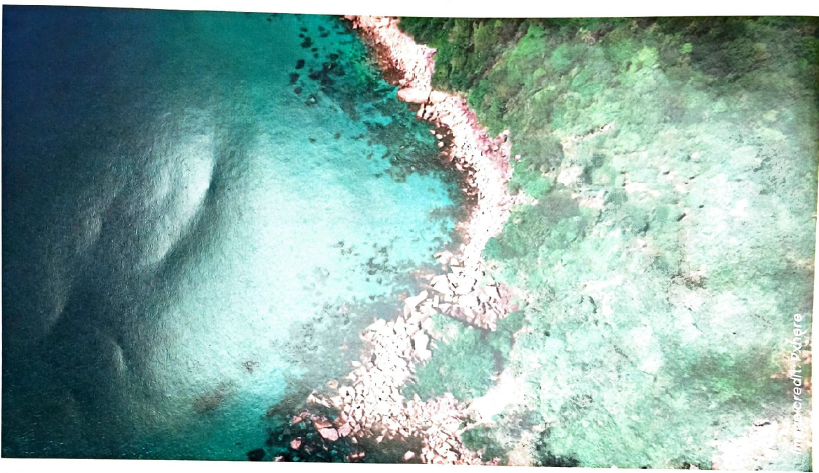
- Freshwater coexisting with salty seawater beneath coastal seas is a surprising yet scientifically recognized phenomenon.
- Historical records from Greek geographer Strabo and Roman author Pliny the Elder highlight the reliance on Submarine Groundwater Discharge (SGD) for freshwater.
- SGD involves the flow of both fresh and recirculated seawater from coastal aquifers into the sea, opposing the process of Seawater Intrusion (SWI).
- This occurs where permeable coastal aquifers, with higher water levels than the sea, extend offshore and discharge water into the continental shelf.
Significance of SGD
- SGD transports trace metals and nutrients into coastal seas, sometimes surpassing river contributions.
- It influences water budgets, geochemical cycles, and marine biology by affecting nutrient levels, eutrophication (nutrient overloading), and hypoxia (oxygen depletion).
- SGD also acts as a pathway for pollutants, including sewage and mining waste, to enter coastal waters, potentially contaminating aquifers and impacting ecosystems.
Drivers of SGD
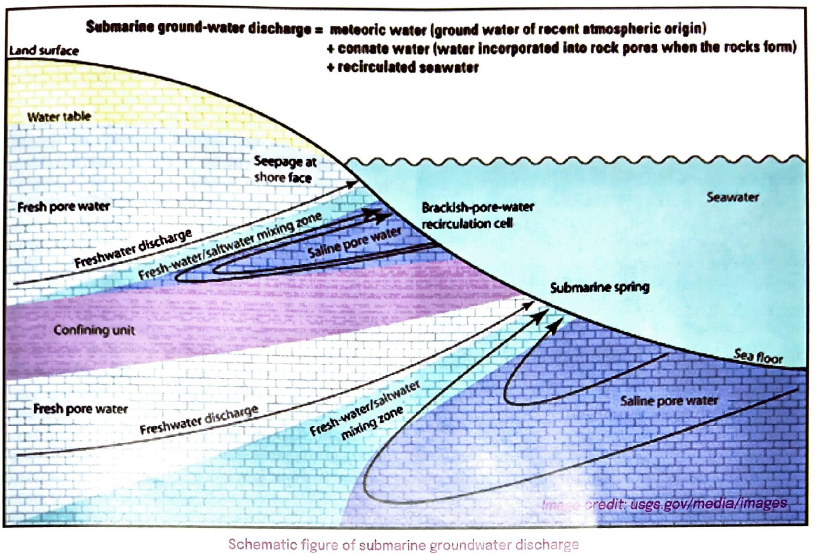
- Factors influencing SGD include rainfall, groundwater recharge, hydraulic gradient, geology, and soil properties (permeability and porosity).
- Tidal movements, seasonal variations, and coastal topography also affect the flow.
- These conditions can change over small distances, making SGD challenging to locate.
Measurement Techniques
- SGD measurement techniques include seepage meters, mini-piezometers, and geochemical tracers (radon, carbon, nitrogen isotopes).
- Hydraulic gradient measurements across sediment-water interfaces, electrical conductivity (EC), pH, and nutrient levels help identify SGD zones.
- Satellite-based temperature anomaly maps (e.g., LANDSAT 8) and computer modeling also assist in locating and quantifying SGD.
SGD Flow Rates
- Global fresh SGD is estimated at 489 km³/year, or 1.3% of river discharge. Tropical coasts contribute 56%, with 41% within 10° of the equator.
- Asia has the highest fresh SGD rate (520 km³/year) compared to Europe (111 km³/year) and Australia (126 km³/year).
- Tectonically active coastlines show higher SGD rates than passive margins.
Uses of SGD
- Drinking – Used since ancient times, from Syria to Peru and Indonesia.
- Hygiene – Fresh SGD is used for bathing and laundry in Fiji, Tahiti, and Mozambique.
- Agriculture – Used for irrigation in Greece and Indonesia.
- Recreation – Supports rich fish populations and marine life (e.g., manatees in Cuba and Belize).
- Cultural Significance – Revered in legends and local traditions (e.g., Olhos de Aqua in Portugal).
Effects on Navigation
- SGD influences ice-free zones, creates dangerous bubbles and waves for vessels, and can damage sea cables.
- A submersible once lost buoyancy due to an SGD spring at 500m depth in the Atlantic Ocean.
Threats to SGD
- SGD faces risks from saltwater intrusion, coastal pollution, climate change, and increased groundwater extraction.
- Rising sea levels and regional subsidence could reduce fresh SGD, as projected for Salento, Italy, by 2200.
Tapping SGD

- Attempts to exploit SGD for drinking water, such as in Italy, France, and Libya, faced challenges due to salinity and high costs of desalination.
SGD in India
- India’s National Centre for Earth Science Studies (NCESS) and Mission SGD have identified and quantified fresh SGD along the Arabian Sea and Bay of Bengal.
- Goa has an annual extractable groundwater resource of 0.317 bcm, with 21% extracted.
- SGD potential along the central-west coast (Goa to Sindhudurg) is supported by geological factors, river discharge, and nearshore topography.
ARTICLE 11
Do not Waste the ‘Wealth’ of Waste
- Waste refers to materials that cannot be used at the source of their generation but may serve other purposes.
- It exists in liquid, gas, or solid form as a byproduct of manufacturing or daily activities. All living organisms generate waste, including human sweat.
- Waste is subjective—what is waste for one may be a resource for another. Its exact composition is often unknown.
Impact of Population and Industrial Growth
- Rapid population growth, industrialization, and urbanization have increased waste generation.
- Improper waste management has caused fatal epidemics like the plague. India generates 63 million tonnes of waste annually, with global waste expected to reach 3.5 billion tonnes by 2050.
- Efficient waste management reflects a country’s development status.
Waste Management for Environmental Health
- Proper waste disposal is crucial for maintaining health and environmental balance.
- Waste management includes collection, transport, storage, treatment, and disposal to eliminate harmful effects.
- The 5Rs—Refuse, Reduce, Recycle, Repurpose, and Reuse—are key strategies. Composting, recycling, waste-to-energy, and reduction at source are common approaches.
Types of Waste
- By Physical State: Solid, liquid, gaseous
- By Source: Agricultural, industrial, urban, rural, domestic, commercial, construction, mining
- By Hazard: Hazardous or non-hazardous
Agricultural Waste Management
- India generates about 350 million tonnes of agricultural waste annually, contributing 26% to greenhouse gas emissions.
- Crop residues can be used as mulch, animal feed, or biogas through anaerobic digestion.
- Manure can produce compost and biogas. Avoiding pesticide contamination and crop residue burning reduces environmental harm.
Urban Waste Management

- Municipal waste includes food, paper, textiles, plastics, glass, and metals. Construction waste consists of concrete, soil, wood, and metals.
- Recycling, composting, and waste-to-energy processes reduce landfill dependency.
- Clinical waste requires legal regulation for safe disposal. Plasma gasification and bioremediation treat hazardous waste.
Wastewater Management
Wastewater includes greywater (household) and blackwater (toilet). Treatment involves four steps:
- Physical: Removal of large solids
- Primary: Sedimentation and skimming
- Secondary: Aerobic biological treatment
- Tertiary: Removal of nutrients and heavy metals
Recycled wastewater supports irrigation and industrial use. Residual sludge can serve as fertiliser or bioenergy.
Plastic Waste Management
- Global plastic consumption is 400 million tonnes annually, with 60% not recycled.
- India generates 15 million tonnes yearly, with only one-fourth recycled. Microplastics harm marine life and human health.
- Strategies include recycling, pyrolysis, road construction, and co-processing in cement kilns.
E-Waste Management

- E-waste contains toxic substances and valuable metals like gold and copper. Only a quarter of e-waste is recycled.
- Acid treatment, incineration, and recycling are common disposal methods. Proper dismantling and data sanitisation are crucial for safe handling.
Space Waste Management
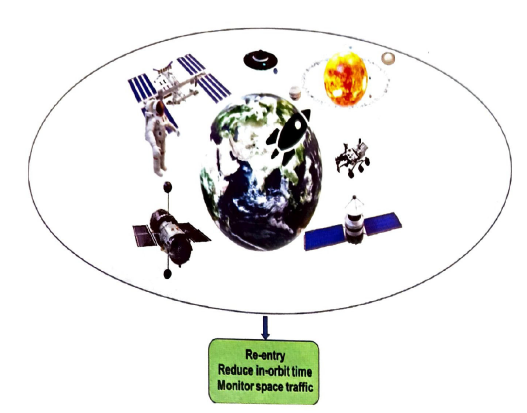
- Non-functional satellites and rocket parts create space debris, threatening future missions.
- Mitigation strategies include satellite health monitoring, debris removal, and coordinated space traffic management.
Harnessing Wealth from Waste
- Agricultural waste can produce biochar, biogas, biofuel, biodegradable tableware, and compost.
- Biochar improves soil health and removes heavy metals from wastewater.
- Nano lignocellulosic materials from waste serve as substitutes for fiberglass and plastic in construction and packaging.
Biotechnology in Waste Management
- Microbes and plants convert toxic waste into useful products. Bioremediation and phytoremediation remove contaminants from soil and water.
- Nanohybrids and carbon dots enhance waste degradation and pollutant removal.
ARTICLE 12
Bioplastics: A Sustainable Hope for Non-degradable Plastics
- Plastic, originally defined as materials that are malleable and easy to shape, has become an essential part of modern life.
- The synthesis of synthetic polymers, primarily derived from petroleum and fossil fuels, has made plastic production easy and cost-effective.
- However, plastic waste poses a major environmental challenge as it does not degrade easily, leading to pollution and waste accumulation.
Environmental Impact of Plastic Waste
- Plastics have become popular due to their durability, affordability, and lightweight nature, with over 300 million tons produced annually — most of it single-use plastic.
- Only 7% is recycled, 8% is burned, and the rest ends up in landfills or oceans.
- Around 10 million tons of plastic waste enter the oceans each year, causing severe marine pollution.
- The chemical structure of plastics, including high molecular weight and crystallinity, makes them resistant to degradation, contributing to long-term environmental issues.
Challenges of Plastic Recycling
- Recycling is an environmentally responsible way to manage plastic waste.
- Mechanical recycling converts plastic waste into raw materials, while chemical recycling breaks down plastics through processes like hydrolysis, glycolysis, and pyrolysis.
- However, the effectiveness of recycling depends on reducing overall plastic production and improving recycling infrastructure.
Rise of Bioplastics
Bioplastics, derived from renewable resources such as starch, cellulose, and plant-based oils, offer an eco-friendly alternative to conventional plastics. They fall into two main categories:
- Biodegradable plastics – Break down naturally through microbial activity (e.g., PLA, PCL).
- Bio-based plastics – Derived from biological sources but may not be biodegradable (e.g., bio-based polyethylene).
Bioplastics can reduce the carbon footprint and environmental impact of plastic production, but their adoption is limited due to production costs and performance variability.
Types of Bioplastics
- Fossil-Based Biodegradable Plastics – Petroleum-derived but biodegradable (e.g., PBAT, PBS).
- Bio-Based Non-Biodegradable Plastics – Renewable but resistant to natural degradation (e.g., bio-based polyethylene).
- Bio-Based and Biodegradable Plastics – Derived from natural sources and capable of decomposing (e.g., PLA, PHB).
Bioplastics from Agricultural Waste
- Agricultural waste, including crop residues and processing by-products (e.g., banana peels, sugarcane bagasse), serves as a potential feedstock for bioplastics.
- This approach reduces waste, lowers production costs, and creates additional revenue for farmers.
- Bioplastics from agricultural waste decompose naturally, reducing plastic pollution and promoting a circular economy.
ARTICLE 13
Triphyophyllum peltatum: Carnivorous in Contingency
- Carnivorous plants are known for capturing insects and small creatures using various tactics like pitfall traps, strong scents, and camouflage.
- Among them, Triphyophyllum peltatum is unique as it becomes carnivorous only under specific nutrient-deficient conditions, particularly phosphorus deficiency, to meet its nutritional needs.
Native Habitat and Classification
- Triphyophyllum peltatum is a rare and endangered species native to Sierra Leone and Ivory Coast in West Africa.
- It belongs to the Dioncophyllaceae family, known for its double-hooked leaves.
- It is the largest carnivorous plant and produces three distinct leaf types at different growth stages, which aid in climbing and insect trapping.
Carnivorous Mechanism
- When phosphorus deficiency occurs, the plant develops glandular leaves with stalked and sessile glands.
- These glands secrete a sticky fluid containing proteases, peroxidases, esterases, and acid phosphatases that trap and digest insects.
- Once the phosphorus need is satisfied, the plant stops producing glandular leaves and returns to normal photosynthesis.
Scientific Discovery
- Scientists at Leibniz Universitat Hannover (LUH) and Julius-Maximilians-Universitat Würzburg (JMU) identified phosphorus deficiency as the trigger for this behaviour.
- Through experiments in botanical gardens and labs, they confirmed that phosphorus shortage causes the plant to shift to carnivory temporarily.
Medicinal Properties
- Research published in New Phytologist highlights the plant’s medicinal potential.
- It shows activity against pancreatic cancer and leukemia cells and combats pathogens responsible for malaria and other diseases.
ARTICLE 14
Oddities of the Natural World – Animals with unusual appearances

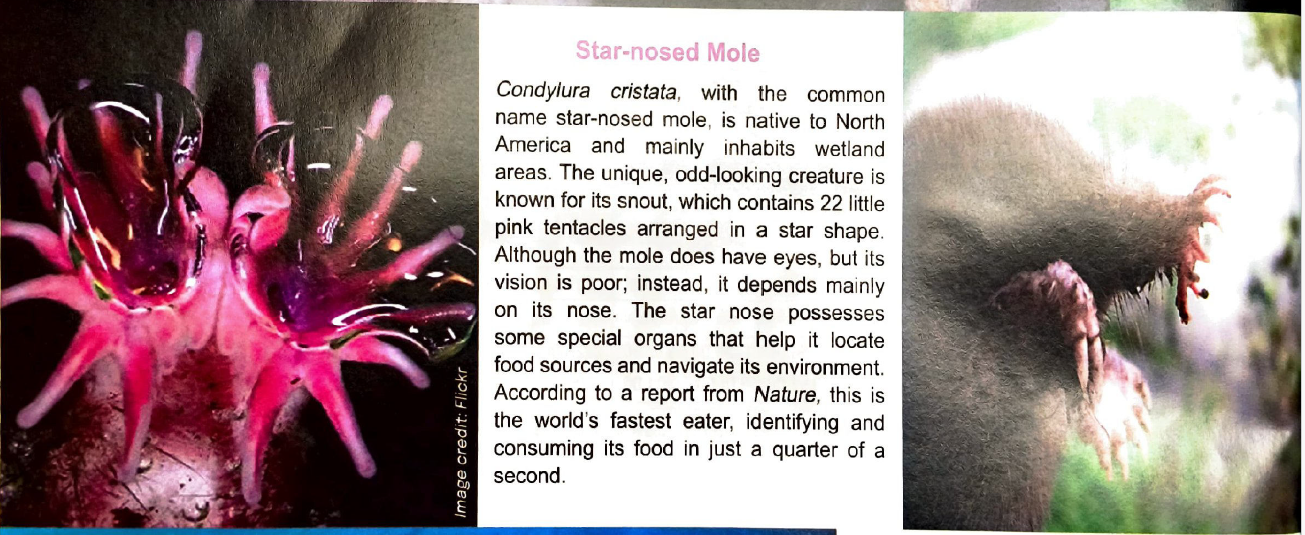



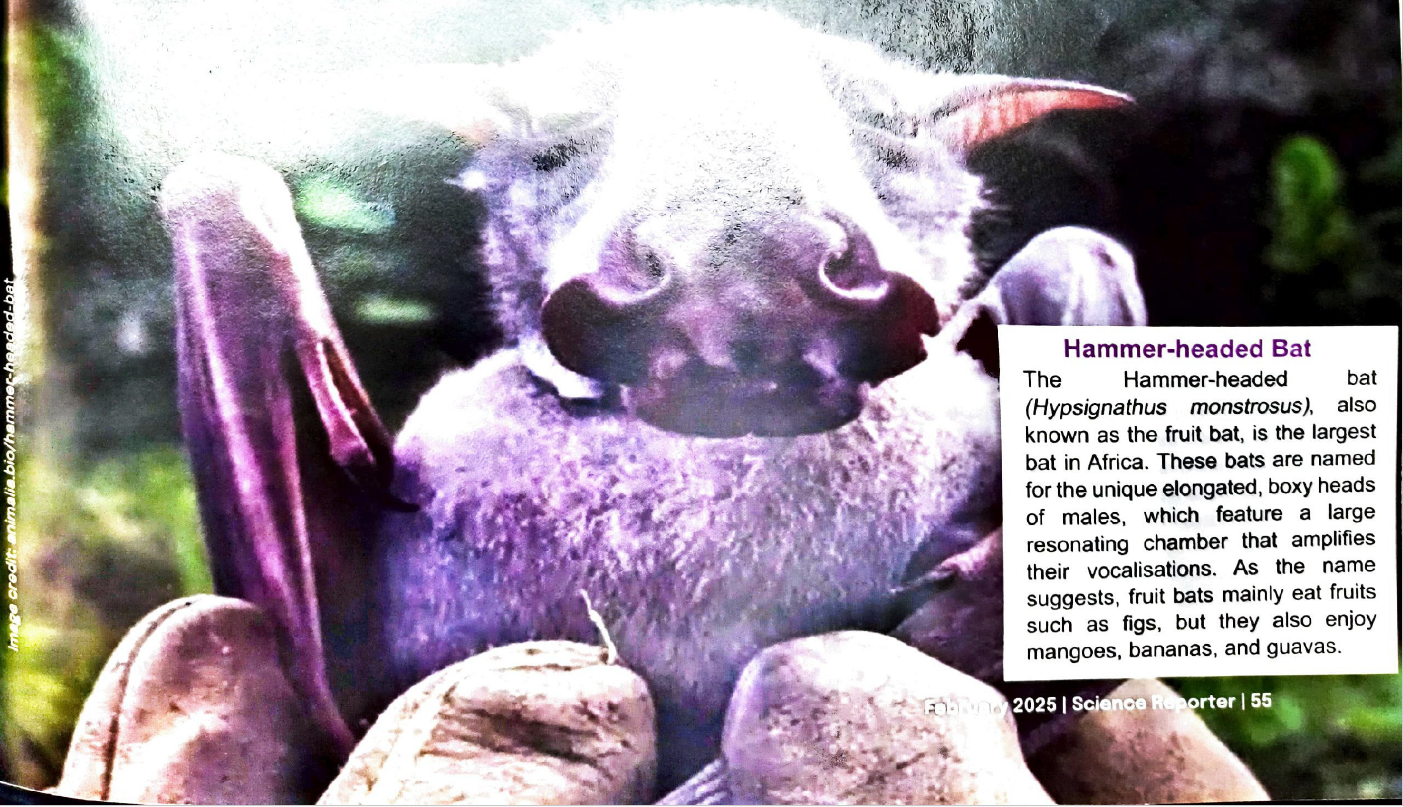
NEWS IN BRIEF
- IIT Bombay develops painless shockwave-based needle-free syringe
IIT Bombay researchers have developed a shockwave-based needle-free syringe that uses high-energy pressure waves from an inbuilt microjet to pierce the skin.
- The nozzle, about 125 µm wide (the width of human hair), makes the process smooth and pain-free.
- It causes less skin damage, reduces infection risk, and prevents needle-stick injuries. The syringe can deliver multiple drug shots, making it cost-effective.
- The study was published in Biomedical Materials & Devices.
2. Researchers develop a Sprayable hydrogel to improve wound healing

- IIT Delhi researchers have developed a sprayable hydrogel that enhances wound healing by releasing calcium, copper, and zinc ions in sync with the body’s natural process.
- In preclinical trials, it healed wounds in 6 days compared to 12 days with current products.
- The hydrogel uses medical-grade Polylactic Acid (PLA) micro-carriers for controlled ion release, improving healing efficiency. The study was published in Advanced Healthcare Materials.
3. Wearable devices can detect and predict inflammatory bowel disease flare-ups
- Mount Sinai researchers have shown that wearable devices can identify, differentiate, and predict flare-ups in Inflammatory Bowel Disease (IBD).
- The study, published in Gastroenterology, suggests that these devices enable continuous disease monitoring and early flare detection using widely available technology.
4. Researchers develop recyclable and fully ocean degradable plastic

- University of California San Diego researchers have developed a wearable ultrasound device for continuous, high-resolution muscle monitoring.
- The battery-powered, wireless device can be stuck to the body, improving muscle tracking and enabling applications in prosthetics, gaming, and human-machine interfaces.
- The study was published in Nature Electronics.
NFOGRAPHICS



